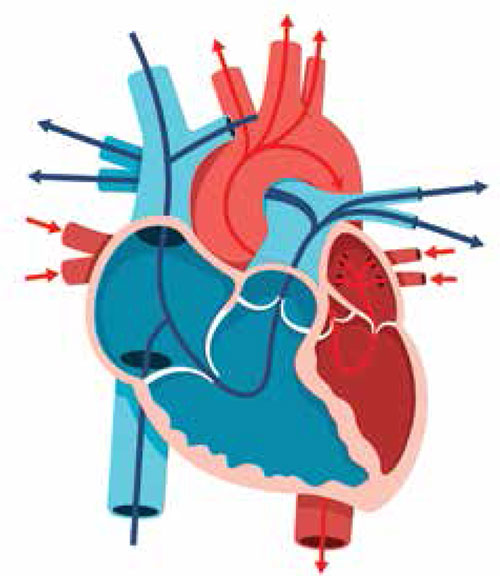
Sacubitril valsartan combines renin-angiotensinaldosterone system (RAAS) inhibition with amplification of natriuretic peptides. In addition to well-described effects, on increased natriuresis and diuresis, natriuretic peptides can also exert direct effects on pulmonary vasculature. The effect of sacubitril valsartan on pulmonary artery pressure in patients with heart failure has not been fully defined. This was a retrospective case-series of pulmonary artery pressure changes following transition from Angiotensin Converting Enzyme Inhibitor (ACEI) or Angiotensin Receptor Blocker (ARB) to sacubitril valsartan in patients with Heart Failure reduced Ejection Fraction (HFrEF) and a previously implanted cardioMEMs pulmonary pressure monitoring sensor.
In this retrospective case series, transition from angiotensin converting enzyme inhibitor or angiotensin receptor blocker to sacubitril-valsartan was associated with an early and significant decrease in pulmonary artery pressure.

Pulmonary Hypertension (PH) is a common comorbidity in heart failure, which may be present in over half of patients with heart failure with reduced ejection fraction. Although PH is associated with a considerably worse prognosis with increase morbidity as well as increased mortality, there have been no successful therapies that directly address pulmonary artery hypertension and unequivocally improve clinical outcomes in patients with heart failure.
Sacubitril valsartan combines renin angiotensin aldosterone system (RAAS) antagonism with amplification of the natriuretic peptide system conferring beneficial compensatory effects in heart failure. Well-defined effects through increased levels of natriuretic peptides include sustained natriuresis, diuresis and improved myocardial structure and function. Natriuretic peptides, which are increased by sacubitril valsartan, are also expressed in the pulmonary vasculature, where they mediate multiple effects, including vasorelaxation and reverse remodelling. In an exploration of possible clinical consequences of sacubitril/valsartan on pulmonary vascular pressure in “real world” ambulatory patients with heart failure pulmonary artery pressures were compiled, before and after the transition to sacubitril valsartan, in a series of 18 adults using the cardioMEMs pulmonary pressure monitoring system.
All 18 subjects had a prior diagnosis of Heart Failure with reduced Ejection Fraction (HFfEF), had been previously implanted with a cardioMEMs monitor, and were being treated with an Angiotensin Converting Enzyme Inhibitor (ACEI) or Angiotensin Receptor Blocker (ARB).Baseline pulmonary capillary wedge, pressure pulmonary artery pressure and pulmonary vascular resistance were all collected at the time of the cardioMEMs implant and abstracted from the medical record. Patients transitioned from angiotensin receptor blocker or an angiotensin receptor inhibitor to sacubitril valsartan were identified, retrospectively, from the medical record and pulmonary pressures were collected from the Merlin website. Up to 3 consecutive, daily pulmonary artery pressures were averaged for each patient from 5 days before transition to sacubitril valsartan and compared with the average of up to 3 daily consecutive measurements in the 5 days after transition for each patient. Two patients on angiotensin receptor inhibitor were started on sacubitril/valsartan after a 24-hour washout period. The remainder were on an angiotensin receptor blocker and transitioned directly to sacubitril/valsartan.All subjects were transitioned to the 24mg/26mg sacubitril valsartan dosage.

The medical charts were also audited in order to verify that other medications that could influence pulmonary artery pressures were not added or changed during the observation window. There were 47 independent measurements prior and 51 measurements following the first sacubitril/valsartan dose. Comparisons of the hemodynamics were performed using Wilcoxon rank-sum testing and two way repeated measures analysis of variance (ANOVA) was performed to assess the effect of transpulmonary gradient on the magnitude of changes in pulmonary artery mean pressures (PAMPs). STATA 14.2. was used for statistical analysis and data management.
While the majority of patients had pulmonary vascular resistance that was within the normal range 137 (73, 172) at baseline, 6 patients had elevated pulmonary vascular resistance and transpulmonary gradients suggestive of mixed or combined pre and postcapillary pulmonary hypertension with pulmonary vascular resistance 357 (320, 548).
Regardless of baseline pulmonary vascular resistance, transpulmonary gradient or diastolic pressure gradient, there were significant pulmonary artery pressure falls.There was a -3.6 mm/Hg (-9.8, -0.7, p < .0001) fall in the ‘low’ pulmonary vascular resistance group and -4.5mm/Hg (-9.8, -3.3, p=0.028), within 5 days of transitioning from angiotensin receptor blocker or an angiotensin receptor inhibitor to sacubitril valsartan for the cohort.Most patients with elevated transpulmonary gradientdemonstrated a “hyperacute response”, which we defined as a>1 standard deviation reduction in pulmonary artery mean pressure within 48 hours of sacubitril valsartan initiation.

Pulmonary hypertension is highly prevalent in heart failure and its presence is associated with considerably worse quality of life, morbidity and survival. Despite this association there are no identified therapies which directly mitigate this risk. Natriuretic peptides, in addition to their role in natriuresis, diuresis and peripheral vasodilation may also play a role in pulmonary vascular tone.
Natriuretic peptides have been identified in animal studies to be secreted and degraded in the lungs and the levels of natriuretic peptides have been noted to be increased in animal models of pulmonary hypertension. Sacubitril valsartan has also been shown to reduce right ventricular pressure in an animal model of pulmonary hypertension. In humans a study by Zern and colleagues showed a rapid fall in pulmonary arterial hypertension and pulmonary vascular resistance in five patients who were hospitalised on inotropic therapy waiting for transplant.Recognised effects of sacubitril valsartan such as increased natriuresis and diuresis, can partly explain the mechanisms of reduction in pulmonary artery pressures through an amelioration of left heart related, postcapillary pulmonary artery hypertension. In addition, the previously discussed studies, along with ours, are part of a growing body of evidence supporting a direct role of natriuretic peptides on pulmonary vascular tone. Such a role might also indicate a potential benefit of neprilysin inhibition in the treatment of patients with abnormal pulmonary vascular pressures and heart failure.
In conclusion, in a small cohort of patients with heart failure with reduced ejection fraction, previously implanted with a cardioMEMs pulmonary artery pressure sensor we demonstrated a significant and acute decline in pulmonary artery pressures after transitioning to sacubitril valsartan fromACEI orARB. Although it is beyond both the scope and the observation window of this exploratory study to determine the long-term benefits of these findings, the results are nevertheless provocative. The acute change in pulmonary artery pressure may represent an attribute of sacubitril valsartan that could have important clinical implications, given the strong correlation between pulmonary hypertension and the increased risk of morbidity and mortality in patients with heart failure reduced ejection fraction. This study also highlights the potential utility and promise of remote sensor technology in assessing clinical response to therapy in ‘real world’ settings.
Tran JS, Havakuk O, McLeod JM, Hwang J, Kwong HY, Shavelle D, Zile MR, Elkayam U, Fong MW, Grazette LP. Acute pulmonary pressure changes after transition to sacubitril/valsartan in patients with heart failure reduced ejection fraction. ESC Heart Fail. 2021 Apr;8(2):1706-1710. doi: 10.1002/ ehf2.13225. Epub 2021 Jan 31. PMID: 33522140; PMCID: PMC8006690.